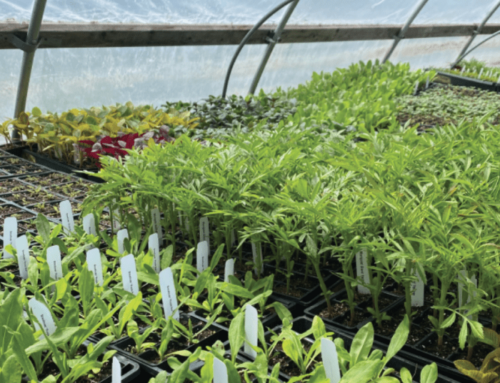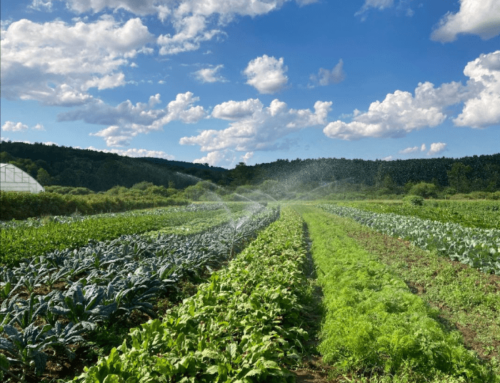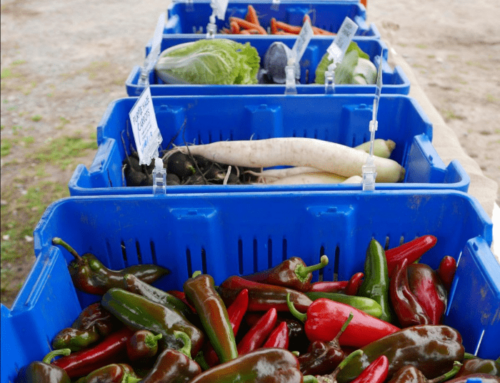By Caro Roszell, NOFA/Mass Education Director

Co-farmers Pete and Jen Salinetti and family,
photo credit: Matt Boudreau
Woven Roots Farm in Tyringham Massachusetts is a diversified organic vegetable CSA farm run by a small farm team managing 1.3 acres in cultivation (360 50’ beds plus paths) on a 10-acre site, roughly 5 of which is owned and 5 of which is leased. The farm grows food for 204 households through their CSA program and also grows for two wholesale accounts on 1.3 acres of land. 80 of their CSA shares are distributed through community partnerships to provide healthy food for low-income households.
Viability: The farm grosses $100,0000 in sales per acre. The farm employs six full-time growers and one part-time employee. The farm owners, Jen and Pete Salinetti, earn 80% of their income each year directly from farm sales, with another 20% of earnings from on-farm education programs.
Practices: The farm is largely hand-scale, using sheet mulching* a year ahead of first cropping as a sod/ termination method when opening new ground. Permanent beds are established and a manual U-bar is used to aerate the soil without turning it. Perennial weeds that survive initial bed prep are removed with a garden fork. Cover crops, cash crops, and mulches are used to keep soil covered, and beds are often flipped (harvested and then transitioned to a new crop via transplants or seeding) in the same season. In this way, multiple crops can be grown in the same bedspace.
Soil Health Indicators

Crop rows at Woven Roots Farm, photo credit: David Edgecomb
Water: A primary indicator of soil health on the farm is the observed water – soil dynamics of their fields. The farm is on a slope, and according to Jen, newly established areas (first year out of sod and into crops production) do show some runoff after heavy rains. In the second year there is less, and by the third year, in heavy rains, the farmers see “no soil movement.” Pathways and beds accept water differently on all fields. “Where the water flows, the permanent beds accept the water, but we do see some water movement in the pathways where we walk. We don’t experience erosion in the aisles due to foot traffic compaction.” Correspondingly, the newer fields require some temporary irrigation, but by the third year of production a field receives only 10-20 minutes of drip irrigation when a crop is transplanted, but will not be watered again. Direct-seeded crops receive overhead water only until germination.
Soil Organic Matter: The farmers apply approximately 4 cubic feet of compost per 50 bed feet (30” beds) to the surface of their beds at each bed transition approximately 1-3 times per season. Combined with mulching, no-till, and cover cropping, their practices build soil carbon steadily. They are now in year 8 farming on their current farm. When they began on this site, the SOM was at 5.7%. They find that areas that have been longest in production are hitting an organic matter threshold of around 12% SOM, past which they do not see annual gains.
The quality and volume of crop production consistently improves over time. Utilizing strict crop rotation, a given area does not grow a crop in the same family for four successions. Areas that are new need to have row covers kept on them for longer periods of time to protect against insects. By the time the same crop is planted in that area again, there is visibly less strain on the plants and noticeably higher and more beautiful yields. Soil and crop testing and nutrient balancing have recently become a more integral part of the farm’s viability.
Incentives and Programs Utilized

Soil aggregates at Woven Roots Farm, photo credit: Jen Salinetti
Jen and Pete have not participated in any State or Federal programs related to soil health or farming practices. They have received funding for infrastructure— to help build greenhouses and a cooler. But their soil health work has been funded entirely within the farm’s operating budget.
The reason they have not participated in available programs is due to farm size and experience. When they first started, they were on a much smaller land base and didn’t qualify for existing programs. Even now, because they own only 5 of the 10 acres they farm, they are excluded from programs that require a minimum of 10 acres to qualify. In fact, they recently worked with their landowner to sign a land covenant that can serve to help them qualify for grants with a 10-acre minimum, but it has required extra assistance and a willingness of the grantor to work with them to qualify.
Jen and Pete’s experience points to a drawback in using land base as an evaluation tool for impact instead of production volume or households served. “When you consider the number of people in each household we serve and the wholesale accounts, we are feeding an average 1,000 people / week on less than 1.5 acres,” explained Jen. Many diversified organic vegetable farms in Massachusetts with that volume of production are cultivating 10 acres or more. Crop intensification can preserve land for other uses and can be more profitable than land-intensification, so designers of policies and programs should be careful not to disincentivize intensification innovation when determining qualification standards for programs.

Tomato plants among mulch at Woven Roots Farm, photo credit: Light Focus Studio
While Jen and Pete are now in their 8th year on their current land, they are in their 20th year of farming, 15 of which they have farmed full time. They have been organic, no-till, and hand scale for almost the whole of their farming career. As a result, State and Federal programs that support beginning farmers are now closed to them. At the same time, they experience a high demand from beginning farmers for support and consulting.
“There are so many incentives for beginning and transition farmers [to healthy soils practices], but for the farmers who have already had these practices in place for many years, for the farmers who have done all this work without getting incentives, there is less support. It would be powerful for there to be incentives for farmers like us to offer consulting and technical support for new or transitioning farmers.”
Focus groups and research confirm that farmers prefer to learn from other farmers, but affording private consulting fees that appropriately value the time and experience of farmers like Jen and Pete can be prohibitive. Jen and Pete are farmers who have learned and designed productive, profitable and ecologically protective farming methods and who could benefit from programs that would hire them to offer technical support to other growers.
Jen stressed the need for consulting programs around healthy soils practices to cover a two-year relationship. “The first two years are the hardest to get past when reducing tillage,” she explained, because the weed pressure is typically quite high and farmers usually don’t see a noticeable improvement in the soil health until the third or fourth year. With increased labor costs and increased challenges, it can be tempting to return to business as usual. “The doubt about whether to stick with it is the hardest thing.”
For more information about NOFA/Mass & NOFA’s broader soil health policy research and work, please check out the companion article in this month’s newsletter.





